 |
|
|
 |
||
Panayiotis Dendrinos1 & Andreas Demetropoulos2,3 The objectives of this particular survey were: Dr. Andreas Demetropoulos, Department of Fisheries The Mediterranean Monk Seal, at least nowadays, when on land seeks refuge in isolated coastal caves (seal shelters). In such seal shelters one or more entrances (underwater or not) lead to a dry flat surface consisting of sand, pebbles, boulders or rock, where the seals haul-out in order to rest or give birth to their offspring. The field team circumnavigated and examined carefully the total length of the coastline within the study area. The team members examined in detail every possible cave entrance. The team members entered the caves by swimming/snorkelling. The suitable caves (seal shelters) were localised by a GPS receiver, measured and sketched. The methodology has as central consideration to minimise disturbance to the monk seals in the process of collecting the necessary data. Thus, at any time when animals observed appear to be disturbed by the presence of the researchers within a shelter, the visit is terminated and the team leaves the area.
1 MOm/Hellenic Society for the Study and Protection of the Monk Seal
18 Solomou Str., Athens GR-10682, Greece
2 Cyprus Wildlife Society, P.O. Box 4281, Nicosia, Cyprus
3 Fisheries Department, Ministry of Agriculture, Natural Resources and Environment, Nicosia, Cyprus
Introduction
The Mediterranean monk seal (Monachus monachus) is considered to be a critically endangered species (IUCN, 1996). Its former distribution extended from the Black Sea, through the Mediterranean to the Atlantic coast of North Africa, as far south as the Cap Blanc peninsula in Mauritania. Currently, its distribution is extremely patchy with fragmentary populations, of which most important are considered the ones in the Eastern Mediterranean and the Mauritania coast (Reijnders et al., 1993, 1997). For most of the species' range, data on the status of the (sub)populations and the availability of suitable habitat are limited. In the island of Cyprus, data on the species have been limited to past reports of animal sightings, which have diminished in recent years leading to the hypothesis that the species may have become extinct.
In May 1997, a field survey was conducted along the western and southern coasts of the island of Cyprus (part of the island that is under the Cyprus Government control). More specifically the survey covered the total length of the coastline from Khrysokhou Bay, in the west part of the island, to Cape Greco, in the Southeast part. The survey was carried out by the Cyprus Wildlife Society, in collaboration with Cypriot authorities (Ministry of Agriculture and Natural Resources, Department of Fisheries), and MOm-Hellenic Society for the Study and Protection of the Monk Seal. The whole expedition was financially supported by SPA/RAC of the UNEP/MAP.
The island has a morphologically and geologically variable coastline of 772 km length. About 50% of this coastline is accessible, either being under the control of the Government of the Republic of Cyprus or found in the two British Sovereign Base Areas. Consequently only this part was surveyed.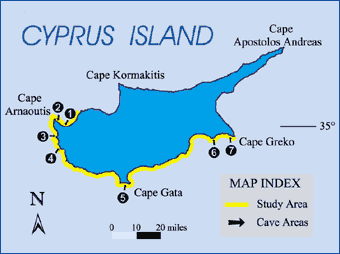
Objectives of the Study
Materials and Methods
The Department of Fisheries' surveillance boat "AMPHITRITI" was used as a base by the research team and a 4m. inflatable with a light, 4 HP out-board engine was used for the detailed examination of the coastline.
The following persons participated in the field survey:
Mr. Panayiotis Dendrinos, MOm/HSSPMS
Mr. Andreas Pistentis, Department of Fisheries
Dr. Myroula Hatjichristophorou, CWS
Mr. Simon Demetropoulos, CWS
The method used by the researchers for approaching and examining the caves has been standardised and tested for a number of years in the area of the National Marine Park of Alonnissos, N. Sporades, Greece, during the long-term monitoring of the monk seal population. According to this method the team approaches the shelters and, depending on the cave, enters each shelter with a dinghy, rowing, or by snorkelling. Using the minimal light source a team member checks the shelter for the presence of any animal:
In parallel, recent information on monk seal sightings were collected through interviews with locals (mainly fishermen).
Results
During the survey approximately 150 nautical miles of coastline were examined in detail for the existence of suitable monk seal habitats. Within the study area 18 different suitable monk seal habitats (sea caves) were identified, explored and charted. Eight of the caves were recorded in the part of coastline north of Paphos up to the Cape Yeronissos (Cave Areas 3,4). Two were recorded in the area of Khrysokhou Bay (Cave Areas 1,2). Six caves were recorded in the area of Cape Gata (Akrotiri, Cave Area 5), one cave was recorded in the area of Cape Pyla (Cave Area 6) and one in the area of Ayia Napa (Cave Areas 7). Four of the above caves/seal shelters were evaluated as being suitable for breeding. Detailed characteristics for the caves identified are provided in the table below.
All the caves were examined thoroughly for the existence of individual seals or for any evidence of recent use by animals. In none of the above shelters were individual seals observed by the team members during the survey. However, an important finding was the existence of seal scats (excrements) in one of the caves (West Coast of Akamas, Cave Area 3). Upon detailed examination, the excrements were found to be fresh (left by the animal, on the rocky beach of the cave, within the last 12 hours). They contained a number of small fishbones. In addition, a seal track was recorded in a cave (Cave Area 2, western part of Khrysokhou Bay).
The above findings provide evidence that monk seal individual(s), although rare, are still found in Cyprus and that, during the study period, used two suitable caves in this part of the Cypriot coastline.
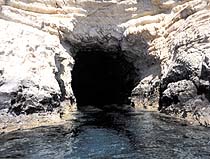
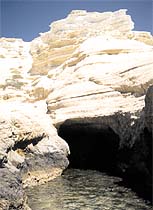
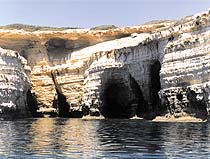
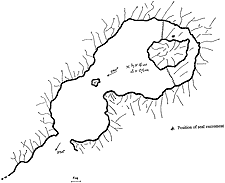
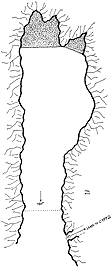
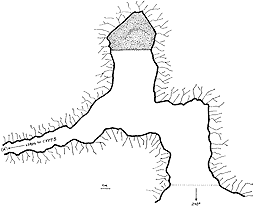
RECENT RECORDS OF MONK SEALS
|
|
|
|
| Thalassines Spilies | 1988 | A single animal |
| Kioni Island | 1991, 1992, 1993, 1994, 1995, 1996 | Reports mainly of a single animal, but two were once mentioned. |
| Cape Yeronissos | 1988, 1989, 1990, 1997, 1998 | A single animal |
| Ayia Napa-Cape Pyla | 1990 | A single animal seen twice |
| Ayia Napa | June 1998 | One animal seen near caves and also near fishing harbour |
| Larnaca Bay | February 1997 | One animal seen near Larnaca fishing harbour and near Cape Kiti |
| Mazotos | February 1997 | One animal seen |
| Fontana Amorosa (N. Akamas) | 1997 | One animal seen on several consecutive days |
| Halavron cave area | March 1997 | One animal seen in 1997. Several sightings in 1998 near cave. |
| Limassol | Summer 1998 | One small animal seen regularly near an offshore fish farm |
| Cape Gata | February 1997, 1998 | One animal seen in 1997. One large animal seen several times in cave area |
| Polis Dasoudi | August 1998 | One animal seen at 1 km from shore — approached fishing boat |
| CHARACTERISTICS OF SEAL SHELTERS |
|
|
(GPS plotted) |
|
|
(m2) |
|
|
|
|
|
|
|
|
|
|
|
|
|
|
|
|
|
|
|
|
|
|
|
|
|
|
|
|
|
|
|
|
|
|
|
|
|
|
|
|
|
|
|
|
|
|
|
|
|
|
|
|
|
|
|
|
|
|
|
|
|
|
|
|
|
|
|
|
|
|
|
|
|
|
|
|
|
|
|
|
|
|
|
|
|
|
|
|
|
|
|
|
|
|
|
|
|
|
|
|
|
|
|
|
|
|
|
|
|
|
|
|
|
|
|
|
|
|
|
|
|
|
|
|
|
|
|
|
|
|
|
|
|
|
|
|
|
|
|
|
|
|
|
|
|
|
|
|
|
|
|
|
|
|
|
|
|
|
|
|
|
|
|
|
|
|
Discussion It is clear that though there has been a serious decline in the monk seal population in Cyprus, the species cannot be considered extinct on the island. We found evidence that at least a small number of animals continues to survive, using mainly the shelters found at Cape Gata and at the west and north-west part of the island. Apart from the direct evidence on the use of caves by the seals collected during this survey, records of recent monk seal sightings further support the use of these areas by the species. Due to the fact that the survey was undertaken during late spring, a period of the year when seals least frequent caves (Dendrinos et al., 1994), the results obtained must be considered as conservative. Thus, in order to evaluate the status of the species in the island, additional fieldwork should be carried out throughout the year and especially during the reproductive period. In addition to monitoring and surveys, however important they may be in enhancing our knowledge, effective conservation will be achieved only when critical habitats for the species receive appropriate protection. The status of this species, as one of the most endangered marine mammals in the world, more than justifies the implementation of effective conservation measures. The two caves, in which direct evidence of the presence of seals was recorded, are already included in the management plans for the core zone of the protected area of Akamas. It can therefore be assumed that these two locations will be protected, from the land side at least, with the implementation of the Akamas management plan. Appropriate protection measures also need to be designed for these caves as regards the adjacent marine area. Similar protection measures have to be envisaged for the other suitable-for- breeding areas recorded, and especially those of Cape Gata and Thalassines Spilies. References Dendrinos, P., E. Tounta, S. Kotomatas, & A. Kottas. 1994. Recent data on the Mediterranean Monk Seal population of the Northern Sporades. Bios (Macedonia, Greece) 2: 11-16. IUCN. 1996. 1996 IUCN red list of threatened animals. The IUCN Species Survival Commission. International Union for Conservation of Nature and Natural Resources, Gland, Switzerland: 1-368 + 10 annexes. Reijnders, P., S. Brasseur, J. van der Torn, P. van der Wolf, I. Boyd, J. Harwood, D. Lavigne, & L. Lowry, eds. 1993. Seals, Fur Seals, Sea Lions and Walrus. Status survey and Conservation Action Plan. IUCN/SSG Seal Specialist Group. IUCN, Gland, Switzerland: vi + 1-88p. Reijnders, P.J.H., G. Verriopoulos, S.M.J.M. Brasseur, eds. 1997. Status of Pinnipeds Relevant to the European Union. IBN Scientific Contributions 8. Institute for Forestry and Nature Research (IBN-DLO), Wageningen, the Netherlands: 1-195.
|
|
|
Copyright © 2000 MOm, Cyprus Wildlife Society, P. Dendrinos, A. Demetropoulos, The Monachus Guardian. All Rights Reserved